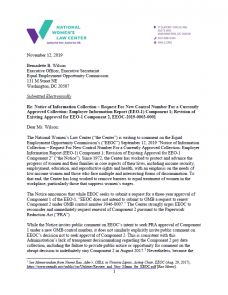 Pay data collection is a critical tool to help stop pay discrimination and close the gender wage gap. Whether by custom or a workplace prohibition, pay information is cloaked in secrecy. Without information about pay, pay discrimination is often almost impossible to detect and challenge. Employees typically have to rely on accidental disclosures to discover they are being paid less on the basis of their sex.
Pay data collection is a critical tool to help stop pay discrimination and close the gender wage gap. Whether by custom or a workplace prohibition, pay information is cloaked in secrecy. Without information about pay, pay discrimination is often almost impossible to detect and challenge. Employees typically have to rely on accidental disclosures to discover they are being paid less on the basis of their sex.
Requiring employers to collect and report pay data helps ensure employer self-evaluation and correction of any unjustified disparities, and enhanced enforcement of pay discrimination laws. For nearly 50 years, companies have confidentially, routinely, and with minimal burden provided to the U.S. Equal Employment Opportunity Commission important information about the sex, race, and ethnicity of employees, by job category, via a form called the EEO-1. The Obama Administration proposed revising the EEO-1 form to require covered employers to submit data on employees’ W-2 earnings and hours worked by pay band, as well as sex, race, ethnicity and job category (known as Component 2 of the EEO-1). The Component 2 pay data collection was adopted in September 2016 after an extensive and transparent process, including a public hearing, a vote by the EEOC Commissioners, and two rounds of notice and public comment.
But in August 2017, without notice or explanation, President Trump’s OMB blocked EEOC’s efforts to collect pay data on the basis of gender, race and ethnicity from employers. OMB called its action a “review and stay.” It was clear the Administration sought to block the equal pay data collection indefinitely, consistent with requests from the business community.
NWLC and other organizations sued the Administration in federal court and won. The court found the stay was illegal, reinstated the pay data collection, and ordered the EEOC to collect two years of data, which is ongoing. But in the meantime, the Administration has appealed the decision, and EEOC announced on September 12, 2019, that it will no longer collect pay data from employers after it completes the current court-ordered pay data collection, claiming the burden to employers outweighed the benefit of the data.
NWLC submitted a comment urging the EEOC to reconsider its decision and seek renewal of the pay data collection (Component 2 of the EEO-1). NWLC’s comment points out that before it had completed, much less analyzed, the current pay data collection, EEOC concluded that the burden outweighed its utility. NWLC argues that EEOC’s burden estimate is questionable and unsupported by information in the Notice, and that pay data is critically important in helping to identify compensation discrimination, improving enforcement of pay discrimination laws, and promoting self-analysis and compliance by reporting employers.
Prior NWLC comments on the EEO-1 Pay Data Collection:
April 2016
August 2016

